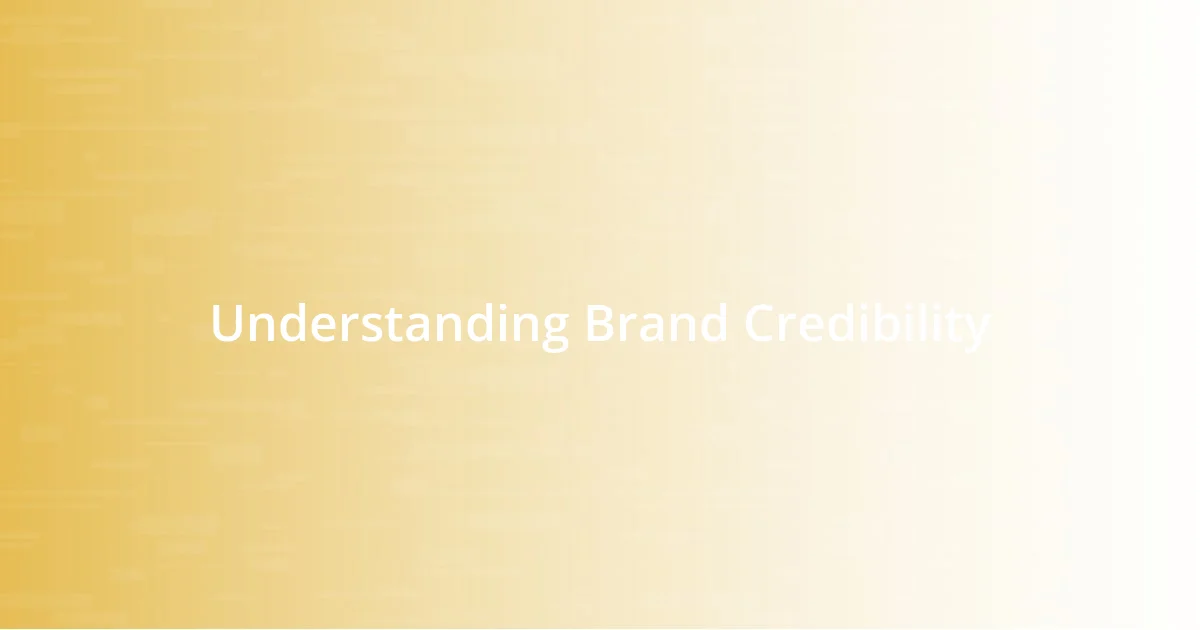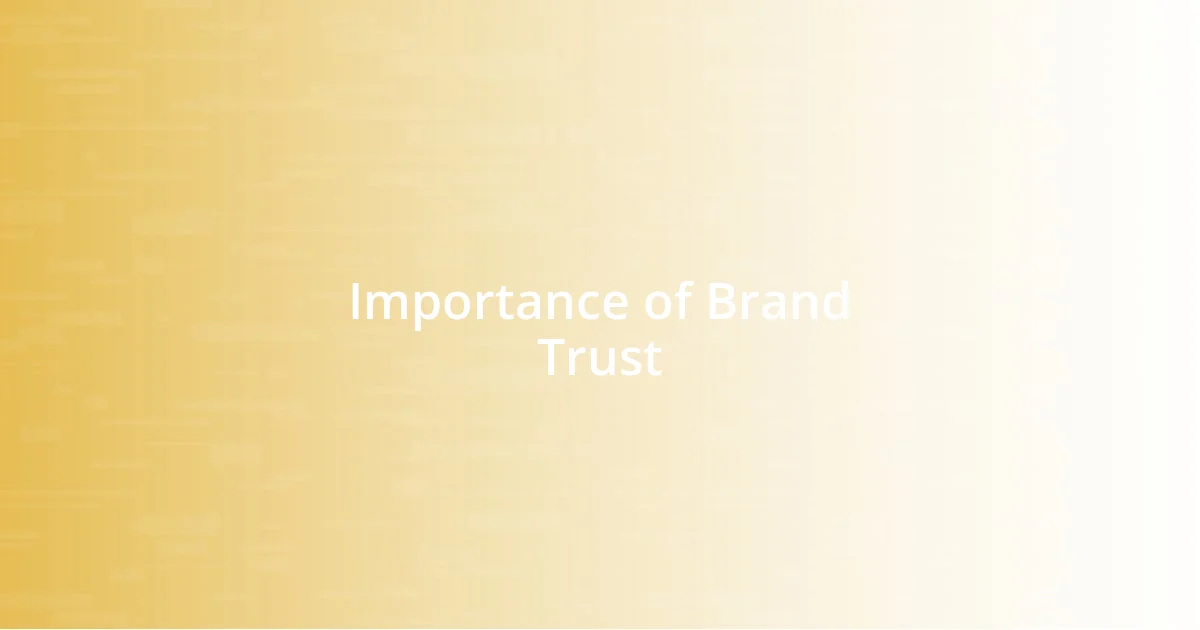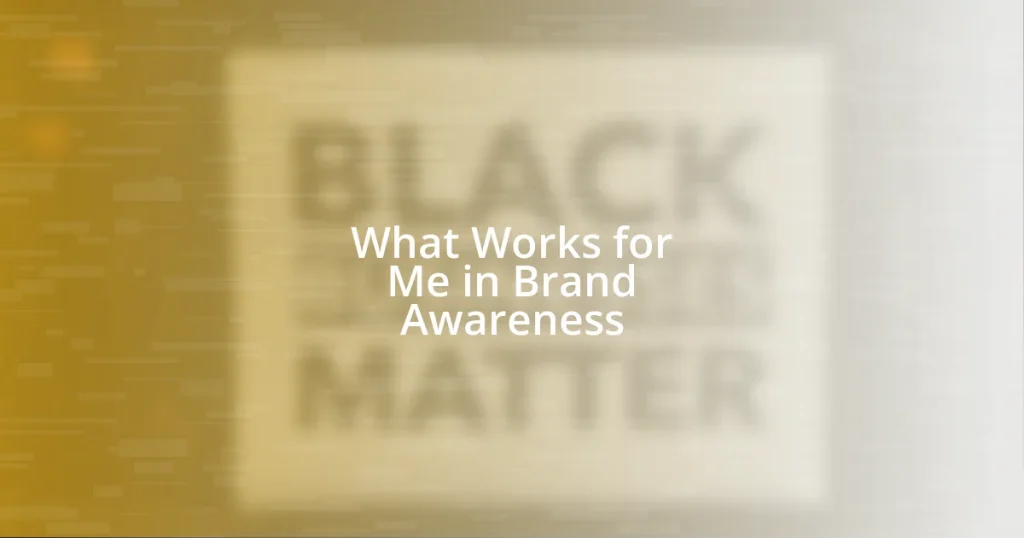Key takeaways:
- Brand credibility is built through consistency, transparency, and active customer engagement, fostering trust and loyalty.
- Establishing brand trust is essential for customer retention and advocacy, significantly enhancing word-of-mouth marketing.
- Monitoring and improving brand reputation through feedback and proactive engagement can transform challenges into opportunities, reinforcing credibility.

Understanding Brand Credibility
Brand credibility is the trust and confidence consumers have in a brand, and it directly influences decisions about purchases. I still remember the first time I chose a product based solely on its reputation; it was a skincare line that my friends swore by. That moment highlighted how critical trust is in establishing a lasting relationship with customers.
To me, brand credibility is built through consistency and transparency. I’ve often thought, how can customers feel secure in a purchase if there are mixed messages? When I launched my brand, I made it a point to ensure that our messaging was uniform across all platforms, from social media to packaging, so that consumers would know exactly what to expect at every touchpoint.
Another essential element is customer engagement. I remember posting a simple question on social media and received an overwhelming response. It made me realize that when brands listen and respond, they nurture a community. This interaction not only fosters loyalty but also reinforces credibility, making customers feel valued and heard.

Importance of Brand Trust
Establishing brand trust is crucial because it creates a loyal customer base. I can clearly recall the moment a customer shared on social media how my product transformed their daily routine. That kind of feedback not only warmed my heart but also reinforced the idea that trust isn’t just an abstract concept; it’s what keeps customers coming back. They aren’t just buying a product; they’re buying into a promise that the brand will deliver.
Moreover, brand trust can dramatically influence word-of-mouth marketing. I’ve seen how satisfied customers become advocates, willingly sharing their positive experiences with friends and family. When I launched my business, a small group of early customers shared their delight on social platforms, which played a pivotal role in introducing my brand to new audiences. This ripple effect shows that trust is a powerful magnet that draws in more customers over time.
Lastly, the importance of brand trust can’t be overstated during critical times. When my brand faced a challenge, I opted for transparency instead of silence. I remember drafting a sincere message to my customers explaining the situation. The response was overwhelmingly supportive, illustrating that honesty during tough times can solidify trust even more. Ultimately, a trustworthy brand can weather storms effectively, proving its resilience in the eyes of its customers.
| Aspect | Brand Trust Importance |
|---|---|
| Loyalty | Fosters repeat purchases and customer retention. |
| Advocacy | Encourages customers to promote and recommend the brand. |
| Transparency | Builds credibility during challenging situations. |

Building a Strong Brand Identity
Building a strong brand identity isn’t just about having a catchy logo or a memorable tagline; it’s the essence of who you are as a brand. Early in my journey, I realized that my brand identity encompassed not only the visuals but also the core values I wanted to portray. For instance, I took the time to participate in charity events closely aligned with my brand’s mission. Connecting with my community not only enhanced my brand’s image but also created a genuine emotional bond with my customers. When they saw me involved in causes they cared about, it deepened their trust and loyalty to my brand.
To create a compelling brand identity, consider these key elements:
– Distinct Visuals: Ensure your logo, colors, and design elements consistently reflect your brand’s personality.
– Clear Messaging: Craft a brand story that resonates emotionally and highlights your unique selling propositions.
– Customer Experience: Pay attention to every interaction a customer has with your brand, from customer service responses to product packaging.
– Consistency: Maintain uniformity across all platforms—this helps reinforce your identity in the consumer’s mind.
– Community Engagement: Actively involve your audience through collaborations or events that align with your brand values.
By focusing on these elements, I found that I could express my brand’s identity more clearly, leading to stronger connections with my customers. This continuous process of aligning actions with my brand identity has not only facilitated recognition but also built lasting relationships, ultimately strengthening brand credibility.

Creating Consistent Brand Messaging
Creating consistent brand messaging has been vital for me in establishing credibility. I remember when I first started out and had a mix of messaging across my website and social media. It felt chaotic, and honestly, I didn’t realize how confusing it could be for customers. Once I committed to a clear, cohesive message that reflected my core values, I noticed a significant change. It was almost like the fog lifted—my audience could finally see who I was and what I stood for.
One of the most effective strategies I’ve used is developing a brand voice that resonates with my target audience. For instance, I made sure to infuse warmth and approachability into my social media posts and customer communications. When a loyal customer commented on how they felt like a friend of the brand, it reinforced my belief in the power of consistency. It made me think: How do my customers feel when they interact with my messaging? This emotional connection has fostered an incredible sense of loyalty and trust.
Additionally, I learned the importance of maintaining that messaging across all channels. Whether it’s an email newsletter or a promotional post, the message needs to feel familiar. I recall a time when I accidentally used a different tone in a campaign email; the feedback I received made me realize how crucial that consistency is. Seeing customers engage positively with my brand every time they encounter it is truly satisfying. It’s a reminder that cohesive messaging not only builds recognition but fosters deeper connections—something I continue to strive for every day.

Engaging with Your Audience
Engaging with your audience requires authenticity. I remember hosting a live Q&A session on social media for the first time. I was nervous, thinking, “What if no one shows up?” But to my surprise, people flooded in with questions. That real-time interaction not only humanized my brand but also illuminated what my audience truly valued. It was this direct feedback that allowed me to tailor my messaging further, making my audience feel seen and heard.
Every conversation is an opportunity to learn about your audience’s needs. I often go through comments on my posts or messages from customers, and sometimes it’s like peeling back layers of an onion. You start with surface-level interactions, but as I dive deeper, I uncover concerns, desires, and aspirations. For example, a customer once shared how a product I offered helped them through a tough time. That wasn’t just a sale; it was a moment where I realized the impact of my work. When you take the time to listen, it shifts the relationship from transactional to meaningful.
Another thing I’ve learned is the significance of storytelling. Sharing personal stories, like how I overcame a challenge in my entrepreneurial journey, has a profound effect on engagement. People connect with stories more than statistics. If I can convey vulnerability and share lessons learned, it invites my audience to relate their experiences. Have you ever had a moment where sharing your story sparked a connection? For me, these moments solidify the bridge between my brand and my audience, reinforcing credibility while creating a community built on trust and shared experiences.

Leveraging Social Proof
When I first started leveraging social proof, I was amazed by its power. I decided to showcase customer testimonials prominently on my website. The shift was palpable; new visitors often commented on how they felt reassured by the positive experiences shared by others. It makes you wonder, doesn’t it? Why do we trust the opinions of others so readily? For me, it highlighted the innate human inclination to seek reassurance from experiences that are relatable.
I also made it a point to share user-generated content on my social media. One memorable moment was when a customer posted a photo of themselves using my product at a local event. I reshared it with a heartfelt thank you, and not only did that foster a stronger connection with that individual, but it also showcased real-life applications of my brand. Seeing my products in action through someone else’s eyes created an authenticity I couldn’t replicate—this was proof that my brand was actively making a difference in people’s lives.
Incorporating influencer partnerships into my strategy turned out to be a game changer as well. I remember reaching out to a well-known figure in my niche who resonated with my values. After her review and endorsement, I was flooded with inquiries and sales. I realized then how impactful it can be to have someone trust your brand and communicate that trust to their audience. It’s a bit like a ripple effect; one endorsement can spark a journey of trust with many others. Have you experienced the thrill of seeing your work validated by someone you admire? For me, it’s a reminder that social proof isn’t just about numbers—it’s about creating real connections and credibility in an authentic way.

Monitoring and Improving Brand Reputation
In my journey, I quickly realized that monitoring brand reputation isn’t just a task—it’s an ongoing commitment. For instance, I set up Google Alerts for my brand name and related keywords. The first time an article highlighted my business in a positive light, I felt a surge of pride, but when I encountered negative comments, it was a reality check. How do we respond to criticism? Instead of getting defensive, I chose to address each concern thoughtfully. This not only improved my reputation but also transformed the narrative around my brand.
Listening closely to feedback has proven essential in my brand’s growth. I remember the day a negative review caught my eye. Instead of brushing it off, I reached out to the customer to understand their experience better. This one conversation not only salvaged that relationship but opened doors to insights that led me to improve my product line. Have you ever turned a negative situation into a positive change? I can assure you, these moments are invaluable for brand credibility, showing your audience that you genuinely care about their experience.
Proactively managing my online presence became another game changer. Regularly reviewing my social media and using tools like sentiment analysis allowed me to gauge how people felt about my brand. I recall a time I discovered a trending hashtag featuring my product in a community discussion. Instead of just watching from the sidelines, I engaged directly, thanking users for their support and sharing their enthusiasm. I was amazed at how this simple act of engagement not only boosted my credibility but also created a passionate community around my brand. Isn’t it incredible how a little proactive effort can shape your reputation in ways you never imagined?















